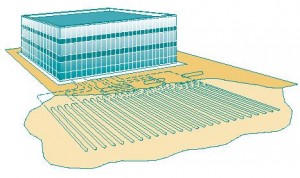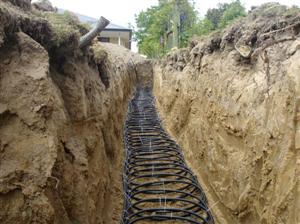Now that you have learned a little bit about geothermal energy and its application in residential areas and the commercial sector, Atlanta Geothermal is sure that you are now wondering where does geothermal energy come from? Good question.
Before you decide to go with one geothermal energy source over another, make sure you have all the facts about them. Luckily, Atlanta Geothermal has already done the research for you and has found that there are three main sources of geothermal energy: horizontal loops, vertical loops, and pond/lake loops.
After you’ve finished reading this article, you should have a better idea which solution will work best for you.
Horizontal Loops
A horizontal loop system is typically the most cost effective geothermal energy solution—assuming that there is sufficient yardspace. Licensed professionals use heavy equipment like backhoes and trenchers to carve trenches about three to six feet below the ground. They then drop in a set of plastic pipes into the trenches before refilling them, ensuring that no debris causes damage or punctures the pipes. Fluid then circulates through the pipes in a closed system, and most horizontal loops are around 500 feet long for each ton of heating and cooling.
Vertical Loops
Vertical loop systems are used when yardspace is limited or when you want to disrupt your existing landscape as little as possible. As the name suggests, vertical loop systems involve a work crew digging a holes ranging in 150-400 feet in depth, and placing a U-shaped pipe in the hole. This pipe is then connected to another pipe that runs horizontally and carries the fluid to and from the indoor exchange unit. Although vertical loops systems require less piping and yardspace, they are generally more expensive to install than horizontal loop systems.
Pond/Lake Loops

Geothermal Pond Loop
Obviously, this geothermal energy solution requires that the building be located near a body of water, as in a pond or lake. Liquid circulates under the water in a closed system pipe system (which can be coiled to preserve space). Because the system is closed, it does not impact the environment as a result of generating energy. If you live near a lake or a pond, then you may want to consider building a geothermal energy solution.
Other Geothermal Energy Sources
There are a few other geothermal energy solutions that are not used as widely as those already discussed. Among them are the open loop and standing column well systems. You can read more about both of these options at the GeoExchange.
Now that you have learned a little bit more about the four different sources of geothermal energy, we at Atlanta Geothermal hope you can make an informed decision whenever you are choosing a geothermal energy solution for your home. It can be a tough call, but don’t worry.
If you have any other questions about which geothermal energy source will work best for your home or business, please Contact Atlanta Geothermal.


